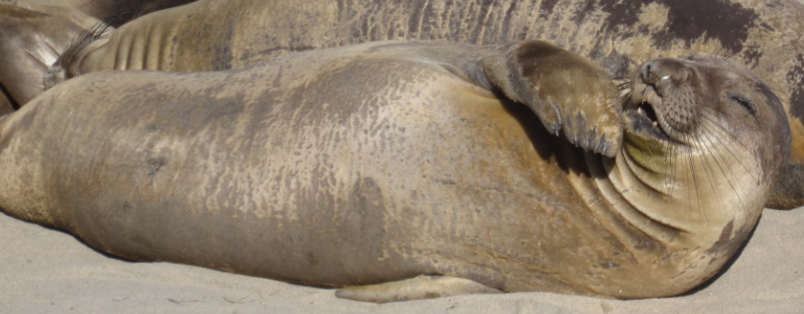I am excited to present this guest blog from Bridget Martinez, graduate student from the University of California, Merced. She has been studying elephant seals in the laboratory of Dr. Rudy Ortiz. She had presented her research at the 2015 Experimental Biology conference in Boston, MA which was mentioned in a prior blog . Here is her description of her research:.
---------
 Bridget Martinez, Graduate Student, University of California - Merced
Bridget Martinez, Graduate Student, University of California - Merced
Northern elephant seals (Mirounga angustirostris) (NES) are fascinating mammals; they possess the incredible ability to fast for weeks without food or water and unlike most hibernators, they remain physically active and are normothermic. As if that wasn't intriguing enough, their fasts are coupled with other extreme physiological events, such as molting, giving birth and mating. The newborn pups are born on land and nursed with a fat-rich diet and four weeks later, they are abruptly weaned. At the time they are abandoned by their mothers to begin their 2-3 month long fast, NES pups contain around 55% body fat, which is meant to sustain them during this time. Alone after their mothers' departure to sea, NES pups will learn to swim along the shore, and ultimately be able to go out to sea for the first time, marking the beginning of a perilous and exciting journey that extends throughout the Pacific, traveling further than any other mammal in world. Representing the true seal of enigma, even after decades of studying these marvelous mammals, it seems as though there is still much insight to be gained from their fascinating evolutionary, adapted physiology.
 Figure 1. Fasting northern elephant seal at the Ano Nuevo Reserve in Santa Cruz, CA. Photo credit: Bridget Martinez.
Figure 1. Fasting northern elephant seal at the Ano Nuevo Reserve in Santa Cruz, CA. Photo credit: Bridget Martinez.
Our studies, to date, have shown that NES pups have developed unique endocrine responses to fasting that are not seen in any mammal adapted to prolonged fasting! For example, we have shown that NES pups are adipose- specific insulin resistant. More interesting, in fasting NES pups, thyroid hormones (TH) increase with fasting duration, suggesting an increase in metabolism in a mammal that is not only fasting but also physically active. We have also shown that the genes regulating their metabolism during the fast, specifically those involved in thyroid hormone regulation, are up-regulated with fasting duration. Given the unique data set, we recently conducted a study in an effort to elucidate the sensitivity of TH regulatory mechanisms in fasting NES pups, through the hormonal stimulation of the thyroid gland. Astonishingly, the study not only highlighted the sensitivity of TH-mediated cellular metabolism, but also showed that sensitivity increased with fasting duration! These data not only confirmed that TH-mediated metabolism increases with fasting duration but simultaneously suggested that these increases are indeed functional and possibly contributing to substrate metabolism. Currently, we are looking at the functionality of this highly perplexing paradox and given that NES pups contain 55% body fat at the time they begin their 2-3 month long fast, we are addressing the hypothesis that this increase in TH-mediated metabolism is specifically and directly contributing to lipid metabolism.
Given the unique endocrine responses that these mammals have evolved to thrive and survive despite such long bouts of food deprivation, we believe that these unique physiological characteristics have evolved as part of their natural life history in order to 1. Contribute to the lipid metabolism of the seal during fasting duration and 2. Stimulate an evolved endocrine signal or surge in energy that, especially for the pups, moves them out to water for the first time, breaking the long fast. These results are proving highly beneficial in providing an intriguing model to better understand the TH-mediated reliance on lipid metabolism that is not otherwise present in morbidly obese humans and elucidating therapeutic targets of thyroid hormones for human obesity.
- Log in to post comments

Very amazing photos.....good blog.